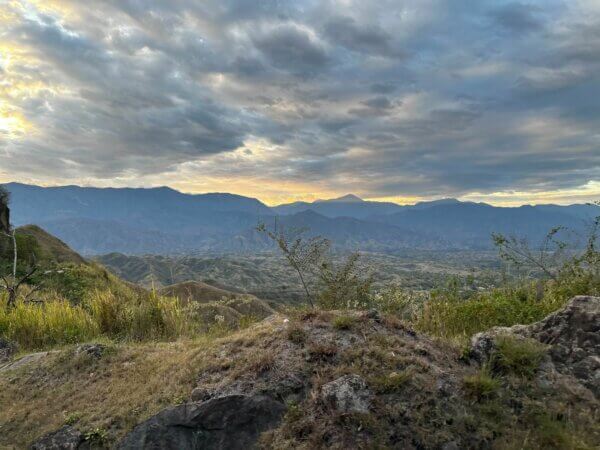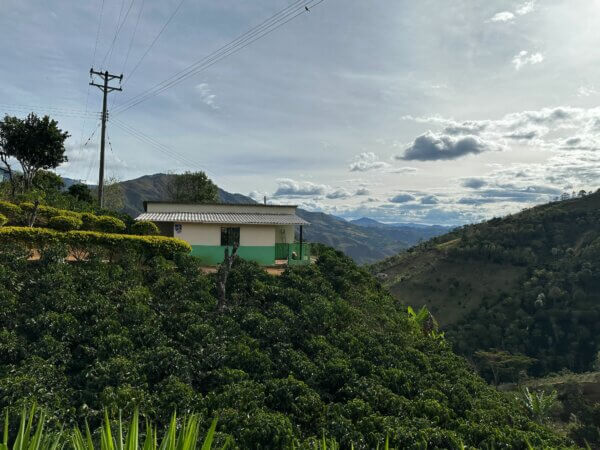Nariño harvest is upon us. After weeks on the ground cupping coffee, talking to producers, and making commitments, we’re excited for the coffees we’re shipping from the Tablon de Gomez subregion of Nariño.
Despite ongoing climate and cost challenges, the coffees we’re bringing in are quintessential Nariño, with notes of red fruit like cherry, red plum, and red apple, complex sweet acidity like lime, rich blackcurrant, sweetness like figs, maple syrup, and cocoa, a creamy body, and a beautiful, notable consistency.

Strengthening supply chains: microclimate, lot construction, logistics, & pricing
Nariño is home to very special conditions that create exceptional coffees. With privileged altitudes between 1700-2000 masl, very distinct and gentle cold and dry seasons, and a variety of microclimates, it’s an ideal geography for growing top-tier Colombian lots. With the coffee-growing areas nestled in windy canyons, quick and even drying of the coffee allows these coffees to reach their full potential.
Because our producer partners work in such small plots, it’s hours and hours cupping each one and making careful decisions about when to separate a single producer and when to build community lots. Community lots are bespoke, carefully constructed to reflect hyperlocal flavor profiles.
From there, we prioritize logistics, making sure the product that arrives in the states is equal to the one that left origin, and in fact has a chance to continue opening up after arrival.
We’ve been working in this area with these specific communities since 2015, when the remoteness of the region meant a lack of strong market access. Now, producers here have options for where they sell their coffee, and we continue to pay premium rates so that the relationships feel mutually rewarding.
All that shines through in the final cup, with the above notes highlighting a brilliant balance of sweetness, acidity, and consistency with a perfect profile for fall and winter menu planning.
Challenges past & present
Visiting Colombia is always exciting but never without a unique set of challenges.
Last year, there was a global price rise that led producers to rush harvest and processing, with many losing quality focus in the sprint for ultra-high prices. This year, prices are 56% lower and most producers have refocused on optimizing quality, which is great to see. But, there have been other challenges this year has brought specifically.
- Climate: June and July brought torrential rains that destroyed the only access road to Nariño. The area was cut off for 2 weeks and producers had to cross the nearby border into Ecuador to buy fuel. Now they’re dealing with the opposite: severe drought and massive forest fires that are devastating various coffee-growing areas, spreading faster in the August winds.
- Economic: The rise in prices of everyday products, such as rice, noodles, and others remains a constant pressure point. Farm inputs are no exception.
- Policy: Given that Colombia is a purely coffee-producing country, the government had provided annual national subsidies for the purchase of fertilizers, which greatly helped producers. This year, the current government—despite having declared that they were going to continue providing this support—has not done so. Several producers have told us that in 2023 they have received zero subsidy, forcing many to significantly reduce fertilizer usage. This, added to the severe drought, is resulting in general stress for the plants.
Despite these stressors, the coffees we’re bringing in are the quailty we’ve come to expect from this unique producing community.

The Journey
It’s a long journey to reach Tablon de Gomez in Southern Nariño. We fly in via Antonio Nariño and cover the extra distance on the Popayán-Cauca road, passing through coffee-growing areas of Cauca before reaching the Cauca-Nariño border (El Bordo Cauca). There, the local Afro-Colombian community welcomes visitors with markets full of tropical fruit, livestock, and milk products like the famous Kumis del Patia.
When crossing El Bordo Cauca, we pass through another region called La Unión, Nariño. This entire area produces coffee at an altitude of 1500-2000 masl. From La Union, we take public transit for another 40 minutes to travel to Buesaco, another coffee-growing region.
In Buesaco, we walk another hour to reach the Tablon community itself. At this point, the whole area is surrounded by small coffee farms: the mountains are bright green with coffee plants and the air is filled with the smell of coffee fruit.
Finally, we arrive at Tablon de Gomez, a small town with two main streets and modern houses. Most of its economy comes from coffee with help from the local sale of bananas and corn.
The town isn’t too full during the week with most residents on their farms. But on the weekend, the community puts up their products for sale and everyone stocks their pantries with food and goods to take back to their farms and continue their work in the field.
| Interested in sourcing coffee with us? Reach out at info@redfoxcoffeemerchants.com. To learn more about our work, check out our journal and follow us on Instagram @redfoxcoffeemerchants, Twitter @redfoxcoffee, Spotify, and YouTube.
|

